
A bottle is a narrow-necked container made of an impermeable material in various shapes and sizes to store and transport liquids and whose mouth at the bottling line can be sealed with an internal stopper, an external bottle cap, a closure, or a conductive "inner seal" using induction sealing. Some of the earliest bottle appeared in China, Phoenicia, Crete, and Rome.
A screw cap or closure is a common type of closure for bottles, jars, and tubes.

A carboy, also known as a demijohn, is a rigid container with a typical capacity of 1 to 16 US gallons. Carboys are primarily used for transporting liquids, often water or chemicals.

A bottle cap or bottle top seals the top opening of a bottle. A cap is typically colourfully decorated with the logo of the brand of beverage. Plastic caps are used for plastic bottles, while metal with plastic backing is used for glass; the metal is usually steel. Plastic caps may have a pour spout. Flip-Top caps like Flapper closures provide controlled dispensing of dry products. Caps for plastic bottles are often made of a different type of plastic from the bottle.
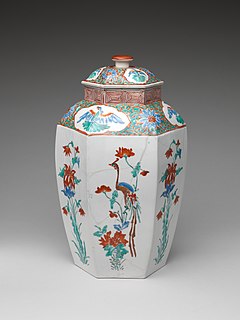
A jar is a rigid, cylindrical or slightly conical container, typically made of glass, ceramic, or plastic, with a wide mouth or opening that can be closed with a lid, screw cap, lug cap, cork stopper, roll-on cap, crimp-on cap, press-on cap, plastic shrink, heat sealed lidding film, an inner seal, a Tamper-evident band, or other suitable means.

A drum is a cylindrical container used for shipping bulk cargo. Drums can be made of steel, dense paperboard, or plastics, and are generally used for the transportation and storage of liquids and powders. Drums are often certified for shipment of dangerous goods. Shipped goods must be matched with the make of drum necessary to comply with applicable regulations. Drums are also called barrels in common usage.

A bunghole is a hole bored in a liquid-tight barrel to remove contents. The hole is capped with a large cork-like object called a bung. Acceptable usage include other access points that may be capped with alternate materials providing an air- or water-tight access to other vessels. For example, a bunghole on a combustion chamber can be used to remove slag or add coal. Bungholes can also be utilized to insert and remove sensing probes or equipment like mixers to agitate the contents within a vessel.
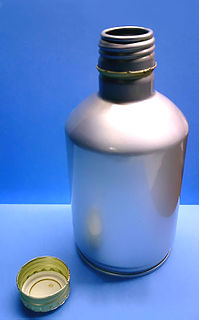
Closures are devices and techniques used to close or seal container such as a bottle, jug, jar, tube, can, etc. Closures can be a cap, cover, lid, plug, etc.
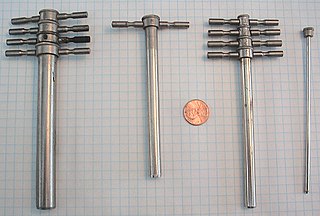
A cork borer, often used in a chemistry or biology laboratory, is a metal tool for cutting a hole in a cork or rubber stopper to insert glass tubing. Cork borers usually come in a set of nested sizes along with a solid pin for pushing the removed cork out of the borer. The individual borer is a hollow tube, tapered at the edge, generally with some kind of handle at the other end.
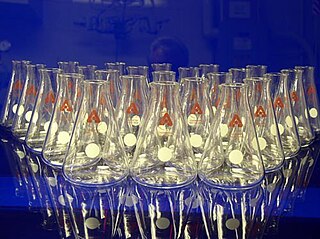
Laboratory flasks are vessels or containers that fall into the category of laboratory equipment known as glassware. In laboratory and other scientific settings, they are usually referred to simply as flasks. Flasks come in a number of shapes and a wide range of sizes, but a common distinguishing aspect in their shapes is a wider vessel "body" and one narrower tubular sections at the top called necks which have an opening at the top. Laboratory flask sizes are specified by the volume they can hold, typically in metric units such as milliliters or liters. Laboratory flasks have traditionally been made of glass, but can also be made of plastic.
Ullage or headspace is the unfilled space in a container, particularly with a liquid.

A glass bottle is a bottle made from glass. Glass bottles can vary in size considerably, but are most commonly found in sizes ranging between about 200 millilitres and 1.5 litres. Common uses for glass bottles include food condiments, soda, liquor, cosmetics, pickling and preservatives. These types of bottles are utilitarian and serve a purpose in commercial industries.
A bung is an apparatus used to seal a container. It may also refer to:

Ground glass joints are used in laboratories to quickly and easily fit leak-tight apparatus together from commonly available parts. For example, a round bottom flask, Liebig condenser, and oil bubbler with ground glass joints may be rapidly fitted together to reflux a reaction mixture. This is a large improvement compared with older methods of custom-made glassware, which was time-consuming and expensive, or the use of less chemical resistant and heat resistant corks or rubber bungs and glass tubes as joints, which took time to prepare as well.
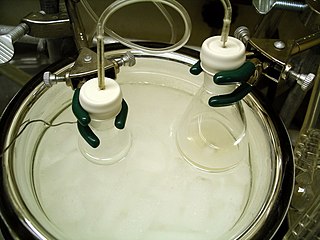
Cannula transfer or cannulation is a subset of air-free techniques used with a Schlenk line, in transferring liquid or solution samples between reaction vessels via cannulae, avoiding atmospheric contamination. While the syringes are not the same as cannulae, the techniques remain relevant.
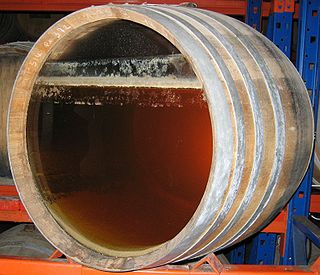
Ullage is a winemaking term that has several meanings but most commonly refers to the headspace of air between wine and the top of the container holding the wine. It can also refer to the process of evaporation that creates the headspace itself or it can be used as a past tense verb to describe a wine barrel or bottle that has gone through the evaporation process. The headspace of air is a mixture mostly of alcohol and water vapors with carbon dioxide that is a by-product of the fermentation process. In containers that are not completely air-tight, oxygen can also seep into this space. While some oxygen is beneficial to the aging process of wine, excessive amounts can lead to oxidation and other various wine faults. This is why wine in the barrels is regularly "topped up" and refilled to the top with wine in order to minimize the head space. In the bottle, the ullage or "fill level" of the wine can be an important indicator of the kind of care and storage conditions that the wine was kept in. After-market resellers and wine auction houses will often inspect the ullage levels of older vintages to determine the potential quality and value of wine.
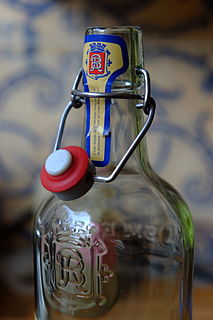
A flip-top, swing-top, or Quillfeldt stopper is a type of closure frequently used for bottles containing carbonated beverages, such as beer or mineral water. The mouth of the bottle is sealed by a stopper, usually made of porcelain or plastic, fitted with a rubber gasket and held in place by a set of wires. The bottle can be opened and resealed repeatedly and without the use of a bottle opener, with the wires acting in the same way as a latch clamp. The flip-top was the dominant method of sealing beer and mineral water bottles prior to the invention of the crown cork.

A laboratory rubber stopper or a rubber bung is mainly used in chemical laboratory in combination with flasks and test tube and also for fermentation in winery. Generally, in laboratory, the sizes of rubber stopper can be varied up to approximately 16 sizes and each of it is specific to certain type of container. As the rubber stopper is used in many experiment, some specific experiment requires a specific material. For example, the M35 Green Neoprene is for chemical resistance. For food fermentation, M18 white natural gum is preferred. For high temperature application, red or white silicone rubber stopper should be used.
The Gutta Percha Company was an English company formed in 1845 to make a variety of products from the recently introduced natural rubber gutta-percha. Unlike other natural rubbers, this material was thermoplastic allowing it to be easily moulded. Nothing else like it was available to manufacturing until well into the twentieth century when synthetic plastics were developed.


















